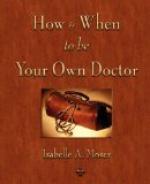Jeanne’s vital force was low; her healing took time. She started on a long fast supported by powdered vitamins, vegetable broth and herb teas, but after three weeks was too weak to do her own enemas at home and could not shop for vegetables to cook into broth. So she had to add one small serving of cooked vegetable per day, usually broccoli or steamed kale. This lasted for one more week but Jeanne, having no financial reserves, had to return to work, and needed to regain energy quickly. Though not totally healed, she progressed to a maintenance diet of cooked grains and vegetables and food supplements, very much like a Macrobiotic diet. She felt better for awhile but wore down again after another stressful year.
Her abdominal pains gradually returned though this time she noticed they were closely associated with her stresses. About one year after ending her first fast, as soon as she could arrange to take time off, she began another. This time to avoid extreme weakness, she took vegetable broth from the outset, as well as small amounts of carrot juice and one small serving of cooked vegetable a day for three weeks. Again, this rest allowed the digestive tract to heal and the pain went away. She returned to her Macrobiotic diet with selected raw foods that she could now handle without irritating her bowel.
She was now healthier then she had been in many years. With improved energy and a more positive attitude, Jeanne returned to University at age 65 and obtained a teaching certificate. Now she is making good money, doing work she enjoys for the first time in 35 years. I hope she has a long and happy life. She is entitled to one!
A Collection of Gallbladders
Gallbladder cases are rather ho-hum to me; they are quick to respond to hygienic treatment and easy to resolve. I’ve fixed lots of them. But an inflamed gallbladder is in no way ho-hum to the person afflicted with it. I’ve been frequently told that there are no worse pains a body can create than an inflamed gallbladder or the sensations accompanying the passing of a gall stone. I hear from kidney patients that passing a kidney stone is worse but I’ve never had a patient who experienced both kinds of stones to give me an honest comparative evaluation.
The only thing dangerous about simple gallbladder problems is ignoring them (between the bouts of severe pain they can cause) because then the inflamed gallbladder can involve the liver. I already told the story of how my own mother lost half her liver this way.
The condition is usually caused by a combination of hereditary tendency, general toxemia, and/or a high-fat diet, especially one high in animal fats. The liver makes bile that is stored in the gallbladder, to be released on demand into the small intestine to digest fat. A toxic, overloaded liver makes irritating sediment-containing bile that inflames the gallbladder and forms stones. A high-fat diet forces the liver to make even more of this irritant.




